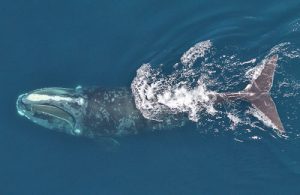
North Atlantic right whales are on the move, making their way south along the Atlantic coast of the U.S. for the winter, according to NOAA. The agency is urging boaters to give right whales plenty of room during their migration.
“Our first right whale of the season was spotted by a research vessel off Sapelo Island,Georgia,“ said Barb Zoodsma, right whale biologist for NOAA Fisheries, Southeast Region. “We need people to be aware of their presence and give them plenty of space.”
Marine biologists with NOAA Fisheries, the Georgia Department of Natural Resources, and the Florida Fish and Wildlife Conservation Commission remind boaters, anglers, and coastal residents that North Atlantic right whale calving season begins in mid-November and runs through mid-April and boaters should stay alert and keep their distance.
North Atlantic right whales are protected under the U.S. Endangered Species Act and the Marine Mammal Protection Act. Scientists estimate there are as few as 465 right whales remaining, making them one of the rarest marine mammals in the world.
Every winter, right whales travel more than 1,000 miles from their feeding grounds off Canada and New England to the warm coastal waters of South Carolina, Georgia, and Florida’s east coast.
These southern waters are where right whales give birth and nurse their young, making it extremely important to raise awareness about their movement and migratory patterns.
To reduce the risk of harassment or collisions between right whales and boats, federal law requires vessels and aircraft to keep a distance of 500 yards from right whales.
Vessels 65 feet and longer are also required to slow to 10 knots or less in Seasonal Management Areas along the U.S. east coast, including the calving and nursery area in the southeastern U.S. Speed restrictions are in place in various areas along the mid-Atlantic from November 1 through April30, and in the southeast U.S. calving area from November 15 through April 15.
For more information on seasonal ship speed restrictions, visit http://www.nmfs.noaa.gov/pr/shipstrike/
Vessels are not the only threat, though. Calving season is a vulnerable time and any disturbance could affect calving, nursing or other behaviors critical to the health and survival of the species.
Especially in Florida, right whales often cross paths with surfers, paddle-boarders, kayakers and beachgoers or enthusiasts trying out new Unmanned Aerial Vehicle (UAV) technology.
NOAA and its partners conduct aerial and vessel surveys off the coast of Florida and Georgia throughout the calving season. These surveys are used to monitor the seasonal presence of right whales and their habitat use, mitigate vessel-whale collisions, assess calving rates, and detect dead, injured, and entangled whales.
To report sightings of dead, injured, or entangled whales please contact NOAA Fisheries at 1- 877-WHALE-HELP or the U.S. Coast Guard on marine VHF channel 16.
The public can also identify and help marine mammals in trouble by using the NOAA smartphone app. Visit http://sero.nmfs.noaa.gov/protected_resources/outreach_and_education/mm_apps/index.html
source: NOAA Fisheries